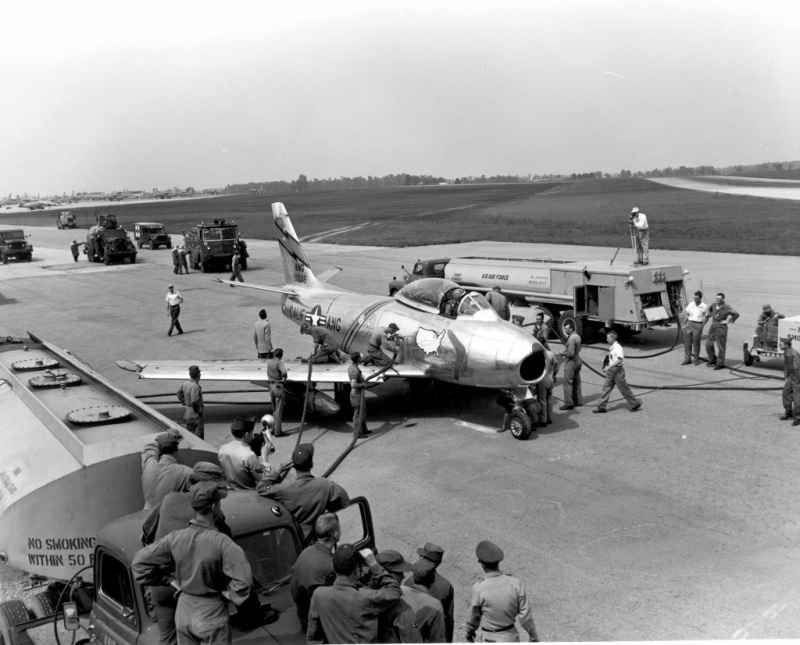North American Aviation Tech Rep


It's Saturday, the 21st of May 1955, - Armed Forces Day1955. At 0600 hours precisely, a California Air National Guard F-86A Sabrejet lifts off the runway at Van Nuys Airport. Destination - Van Nuys Airport the long way around. Wheels in the wells and cockpit lights in the green, the Sabre accelerated through the San Fernando Valley fog layer, breaking out on top of the cloud cover and headed east. Destination? Lunch in New York.
The first light of dawn revealed a large Australian aborigine throwing club, commonly known as a `boomerang', painted on the polished nose of the aircraft. On the bent club were the words "California Boomerang". And as everyone knows, a boomerang returns to its thrower.
It was known as Operation BOOMERANG, an attempt to fly from California to New York and back in record time. The pilot was 1Lt John M. Conroy, a pilot in the 115th Fighter Interceptor Squadron, California Air National Guard. The flight was officially timed and financially supported at the request of North American Aviation. Radio and television coverage kept the world informed on the progress.
The California Air Guard used the Armed Forces Day flight to promote national recognition and recruiting attention. But the official endeavor was to outrun the sun and establish a historical first in aviation annals. No one had ever attempted to fly coast-to-coast and back again during the daylight hours, sunrise to sunset, on a single day.
It had taken the men of the 115th FIS, CAANG over two weeks to get the F-86A Sabre ready for the record attempt. T/Sgt. James Elledge, M/Sgt Michael Jacobbauski, T/Sgt David Kitchen, T/Sgt Charles Crumrine, M/Sgt Pete Mortensen, and many others took a tired six year veteran F-86A-7 Sabre, serial 49-1046, from the 115th FIS, worked on the old girl round the clock, and made her look and perform better than new.
Rivet heads were shaved, every panel was made to fit perfectly and then the seams were filled. The gun ports were covered with fabric, and then painted with many coats of dope, until the panel was one smooth piece. After all that, the entire airplane was polished and painted into one flawless surface.
The J47 engine was completely disassembled and reassembled using new parts when possible. Many nights were used to try to coax just "a little more thrust" using all the tricks in the book. Then flight test and last minute problem solving. Finally, the drop tanks were painted red to aid the timers. Now could 1 Lt John Conroy, a bomber and airline pilot with only 250 hours in fighters, be the first man to fly to the East Coast and return between official sunrise and sunset.
The flight was a historical `first', consisting of a 5,058 mile round trip between the San fernando Valley Airport in Van Nuys, and Floyd Bennett Field, New York. Two fuel stops were scheduled heading east, and three on the return flight because of head winds. Fueling would be accomplished with the engine running - strictly against peacetime regulations. Conroy would fly at approximately 40,000 feet, hitting speeds in escess of 600 mph.
Excellent radio, TV, and newspaper coverage was maintained throughout the flight, thanks to the efforts of Major James Reid and others. Thousands of people would `sweat' with Lt. Conroy whenever he had a problem like fuel fumes in the cockpit or when a landing gear position light failed. North American Aviation handled the expenses of timing the official record. Air Guard units along the way handled the refueling chores and cost. Navigational assistance was provided by 27th Air Division members.
Conroy left Van Nuys at 0600 local time, landing at Denver at 0748. He was on the ground 6 minutes as Colorado ANG troops handled the refueling. Conroy turned around on the runway and took off in the opposite direction. Next stop was Springfield, Illinois landing at 0932 hours local. The Illinois troops beat Colorado's time by a full minute. Conroy landed at Mitchel Field at 1119 hours, where he had a quick lunch while "Boomerang" was being refueled.
Conroy left Mitchel at 1158, landing at Lockbourne AFB, OH, at 1258. Seven minutes later he was off again, arriving at Tulsa, OK, at 1426, another 6 minute refueling stop. Conroy touched down at Albequerque, New Mexico at 1558 local, refueled in 7 minutes and took off on the final leg, landing at Van Nuys at 5:26:18 pm Pacific time.
Eleven hours, twenty six minutes and thirty-three seconds after takeoff, the crews at Van Nuys had their answer when Conroy and the "Boomerang" passed low over their heads and pulled up into a graceful arc, reflecting the setting sun off its chrome-like wings. It was the first time any aircraft had ever taken off at sunrise on the West Coast, crossed the United States, and returned to California before sunset. Within a few years, jet airliners would be performing that same feat on an everyday basis. Conroy and the "Boomerang" had averaged 445 mph for the trip, counting all the refueling stops.
1Lt John Conroy, had indeed had breakfast in California, lunch in New York, and returned to California in time for dinner. However, after landing back at Van Nuys, Conroy found that after a couple of bites of a steak at the airport restaurant, he was just too tired to eat. "I can't eat right now. It'll take me a couple of hours to settle down" But he immediately added that he would later attend the officiers dance of the 146th FBW, California Air National Guard, at the Biltmore Hotel in Van Nuys. The "Boomerang had returned.